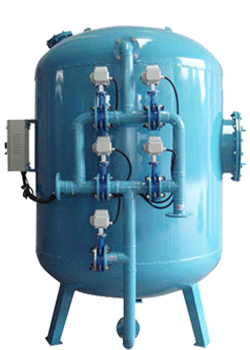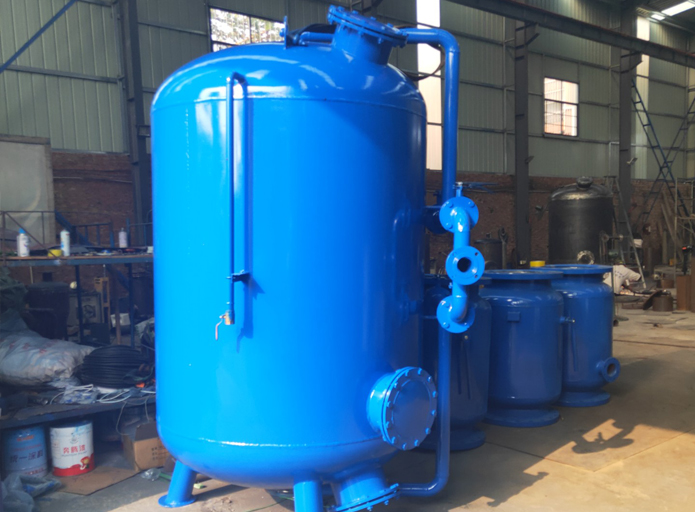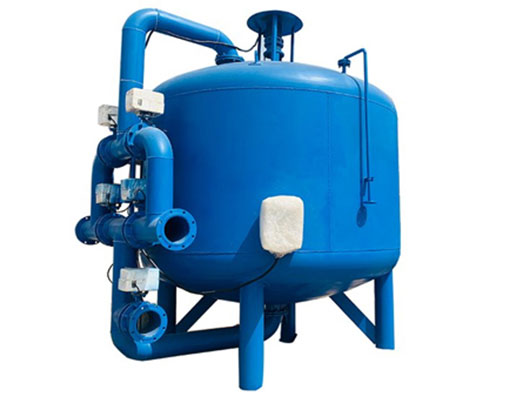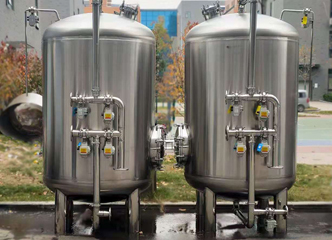In cooling water treatment, quartz sand filters play an important role. It can effectively remove suspended solids, organic matter, colloids and sediment in cooling water. Here are some more detailed application details:
Cooling water treatment: Quartz sand filters are widely used in cooling water treatment in various industrial fields, such as electronic power, chemical industry, etc. Cooling water often contains impurities and harmful substances. Quartz sand filters can effectively remove these substances to ensure the stable production process and safe operation of equipment.
Treatment process: Quartz sand filter uses quartz sand as the filter medium to filter water by letting water pass through the quartz sand filter layer under a certain pressure. Because quartz sand has a large specific surface area, when water flows through the filter layer from top to bottom, it can effectively intercept and remove suspended solids, organic matter, colloids and sediment in the water.
Cooling tower treatment: In cooling water systems, quartz sand filters can also be used to treat impurities precipitated by cooling towers. This application can effectively prevent scaling inside the cooling tower and ensure the normal operation of the cooling tower.
Pressure vessel application: The design and manufacture of quartz sand filters also need to comply with pressure vessel regulations to ensure safe operation in high-pressure working environments.
Service life of filter media: Although the service life of quartz sand filter media is affected by factors such as water quality and flow rate, with correct management and regular replacement, quartz sand filter media can have a long service life.
Pretreatment equipment: Quartz sand filters are also often used as pretreatment equipment, such as for treating cooling water with high turbidity, or as pre-treatment for softened water, electrodialysis, reverse osmosis, etc., to improve the efficiency of subsequent treatment equipment. Processing efficiency and effectiveness.
In general, quartz sand filters play an important role in ensuring good water quality of cooling water, preventing equipment corrosion, and improving cooling efficiency. At the same time, we also need to note that the operation of the quartz sand filter requires regular backwashing and maintenance to maintain its good filtration effect.

The working principle of quartz sand filter is quite direct and effective. Its working process is mainly divided into the following steps
1. Water inlet: Water containing impurities is injected into the filter from the water inlet and first enters the distributor.
2. Pressure filtration: The quartz sand filter is a pressure filtration equipment, which means that during operation, the water is pressurized to force the water flow through the quartz sand filter material.
3. Distribute water flow: The water entering the filter is evenly distributed to various parts of the filter material through the upper distributor to ensure that the pressure on the horizontal plane is consistent and the entire filter material bed is filtered.
4. Use quartz sand as filter media: The inside of the filter is filled with refined quartz sand filter material. These quartz sand filter media provide reliable filtration performance. The gaps between quartz sand particles form countless small channels. When water flows through these channels, various particulate pollutants are trapped in the filter bed.
5. Layered filtration: Quartz sand filters are generally filled with quartz sand of two or more particle sizes in layers, so that the filter bed forms a thickness gradient, which is beneficial to improving filtration accuracy.
6. Adsorption and interception: After the above process, suspended solids, organic matter, colloids, sediment and other impurities in the water will be adsorbed and intercepted by the quartz sand filter material, thereby reducing the turbidity of the water and improving the cleanliness of the water. .
7. Collect treated water: The water collector at the bottom collects and collects the treated clean water and outputs it through the water outlet.
8. Normal operation and backwash update: After the quartz sand filter has been working normally for a period of time, as the filtration time goes by, the impurities in the filter bed gradually increase, and the operating resistance gradually increases, requiring backwash and cleaning. Restore the filtration capacity of the filter bed. Backwashing refers to changing the direction of the water flow to expand the filter material bed, causing the pollutants attached to the filter material particles to backwash out of the filter with the water flow, thereby achieving the purpose of regenerating the filter material bed.
In general, the working principle of the quartz sand filter mainly utilizes physical filtration and adsorption to effectively remove suspended solids, particulate matter, organic colloids and other pollutants in the water through the quartz sand filter material in the equipment. This design gives the quartz sand filter the advantages of large processing capacity, stable and reliable operation, and easy maintenance.

The advantage of quartz sand filter lies in its unique design and materials used, which has the following significant advantages
1. Powerful filtration capacity: The filter can effectively remove suspended solids, sediment, rust and other impurities in the water. Whether it is relatively large particles or fine suspended particles, they can be effectively filtered. This significantly improves water clarity and transparency, providing users with clear and pure water.
2. High filtration precision: Due to the adjustable particle size of quartz sand, various filtration needs from coarse sand to fine sand can be accurately met. For the filtration of tiny particles, the quartz sand filter can also easily handle it, ensuring its filtration effect on all types of particles.
3. Durable and easy to maintain: Quartz sand itself has high hardness and wear resistance, and its anti-extrusion ability and wear resistance are very strong. Therefore, filters using quartz sand as filter material have a longer service life. At the same time, the filter has a simple structure and stable operation. Even when special maintenance is required, it is easy to maintain and does not require frequent replacement of parts.
4. High filtration efficiency: The quartz sand has a large specific surface area, forming numerous tiny filtration channels, allowing water to pass through the quartz sand layer more effectively, increasing the filtration efficiency.
5. Strong chemical resistance: Quartz sand is highly resistant to chemicals such as acids and alkalis, is not susceptible to corrosion, and can operate stably in a variety of water quality environments.
6. Large capacity and fast speed: The quartz sand layer inside the filter can absorb a large amount of impurities. The filter element has a long cleaning cycle and a fast filtration speed. It can process a large amount of water sources in a short time and is suitable for water treatment needs of various scales.
All of the above allow quartz sand filters to exert their unique advantages in various environments, especially in the filtration treatment of hard water and high turbidity water, greatly improving the availability of water and ensuring the safety of water.
The internal structure of the quartz sand filter mainly consists of the following parts
1. Container shell: The container shell is the main body of the equipment. It mainly carries quartz sand and water flow and plays a role in peripheral protection. Generally made of carbon steel or stainless steel with moderate thickness, it has good mechanical strength and corrosion resistance and can handle a variety of working conditions.
2. Quartz sand medium layer: The quartz sand layer is the main filter medium of the equipment. Its main function is to filter suspended solids, sediment and other granular impurities in the water. The particle size of quartz sand can be selected according to needs to achieve different filtration effects.
3. Upper distribution system: The upper distribution system is mainly responsible for evenly distributing the water entering the filter to the filter material. The design of the distribution system requires that the water flows evenly from top to bottom inside the filter, ensuring that all water can be processed by the filter material, thereby ensuring the filtration effect.
4. Water outlet system: The water outlet system is located at the bottom of the filter. It is mainly responsible for collecting filtered clean water, and often also has the function of backwashing the air pipe. That is, when the filter material needs to be cleaned, the explosive air is blown into the filter in the reverse direction. , so that the filter material can be completely cleaned under the action of explosive gas.
5. Bottom sewage system: The bottom sewage system mainly includes a certain number of sewage valves. This is an important part, which can discharge water containing impurities when the filter is backwashed to avoid contaminating the subsequent water purification system.
In addition, the operation of the quartz sand filter usually requires an inlet valve, an outlet valve, a drain valve, etc. to control the normal operation and maintenance of the equipment.
This kind of equipment has mature technology and is widely used, and can adapt to various water quality and flow requirements. At the beginning of the design, the designer will consider the actual operating environment and working conditions of the equipment to select appropriate structures and materials to ensure the operational reliability and durability of the equipment.

The selection of quartz sand particle size is very important in the operation of quartz sand filter, which affects the filtration speed and filtration effect. The following are the specific selection criteria
Selection of double-layer filter tank: In double-layer filter tank, quartz sand with a particle size between 0.5mm and 1.2mm is often used. The reason for using a double-layer filter tank is that it can not only ensure the water discharge effect, but also extend the filtration cycle and save backwash water.
Filter material accuracy requirements: When using quartz sand filter material within the particle size range, the quartz sand filter material is required to be no more than 3% smaller than the specified particle size. If the particle size is larger than the specified upper limit, the proportion in the quartz sand should be no more than 2 %. Strictly controlling this value will help improve the filtration effect of suspended solids and the working capacity of the filter.
Filtration needs and water quality conditions: The appropriate quartz sand particle size needs to be determined based on the actual treated water quality, its turbidity, and the size of granular pollutants. If the water quality is relatively clear, you need to choose quartz sand with a smaller particle size to solve the filtration problem of fine impurities; if the water quality is high in turbidity, you need to use quartz sand with a larger particle size to achieve efficient filtration.
Differences in filtration effects: Quartz sand with different particle sizes has different filtration effects and filtration speeds. Coarse-grained quartz sand has a relatively fast filtration speed, but its filtration effect on tiny particles is poor; fine-grained quartz sand has a slower filtration speed, but its filtration effect on tiny particles is better.
Therefore, the selection of quartz sand particle size requires comprehensive consideration of relevant factors, including water quality conditions, filtration needs, equipment performance and economic benefits. At the same time, specific choices should be made in consultation with professional filtration equipment suppliers or technicians to ensure the normal operation of the equipment and the water filtration effect. In actual operation, the equipment must be maintained and tested regularly, and the particle size and quantity of the filter material should be adjusted according to the operating conditions to ensure the filtration effect.

The size of quartz sand particles has a very important impact on the operation and effectiveness of quartz sand filters. Specifically, the following are the possible effects of quartz sand of different particle sizes
The particle size of quartz sand is too large: When the particle size of quartz sand filter material is too large, on the one hand, fine suspended impurities can easily penetrate the filter layer, causing the quality of the effluent to decrease. On the other hand, too large quartz sand particle size cannot fully loosen the filter layer during backwashing, resulting in unclean backwashing. Sediments and quartz sand filter materials are prone to "caking", resulting in uneven filtration water flow and causing the filter to quickly fail.
The particle size of the quartz sand is too small: When the particle size of the quartz sand filter material is too small, it will increase the water flow resistance and increase the filter head loss too quickly, thus shortening the filtration cycle and increasing backwash water consumption.
Moderate quartz sand particle size: Choosing the appropriate size of quartz sand can further improve filtration efficiency. When the particle size of the filter material is moderate, good filtration effects can be achieved while reducing back pressure. A filter material particle size that is too large or too small may reduce the performance of the filter, resulting in the need for frequent maintenance in the short term.
Overall, each size of quartz sand has its own pros and cons that come with it. The right choice depends on your specific needs, system pressure, flow rate, and the size of suspended impurities, among many other factors.









